Those who believe, all that is hard for evolution to explain, are answered by saying; given time, chemical processes, environmental pressures, etc, will result in changes.
That thinking then accepts eyes will eventually evolve, sexual reproduction gradually forms, etc.
People who believe in God see these ‘hard areas’ as things to marvel at God’s creative genius.
Table of Contents menu:
Table of Contents:
1. Migration is hard for evolution to explain
The American Golden Plover is an extremely rare visitor to the UK each year.
From spring, look out for the beautiful, speckled gold-and-black breeding plumage of the American Golden plover.
‘Golden plover’ Scientific name: Pluvialis apricaria The Wildlife Trusts. 1
It can be found in its upland moorland breeding grounds from May to September, moving to lowland farmland and fields in winter.
It nests on open ground among heather and grass, and the female lays about 4 eggs.
Both parents care for the chicks.”
It is a first class navigator:
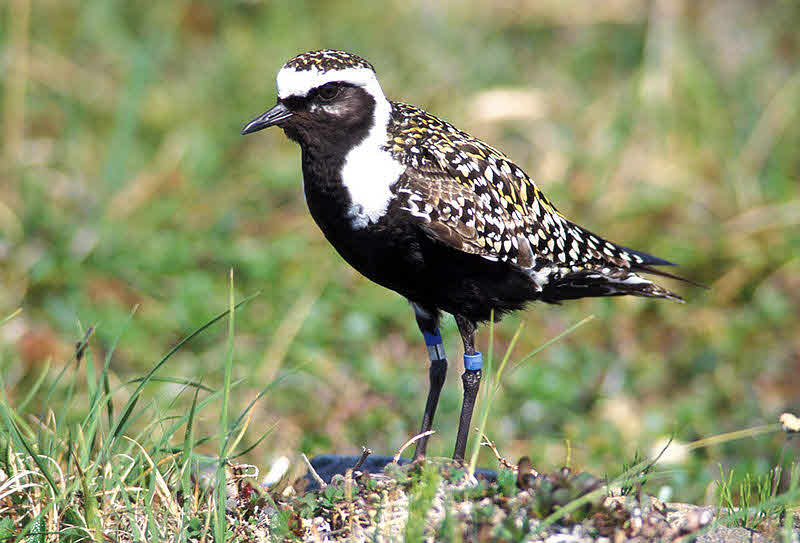
The American Golden-Plover has a long migration route.
‘American Golden-Plover’ All About Birds, The Cornell Lab 3
In the fall, many fly offshore from the East Coast and don’t land until they reach South America.
In spring, most pass through the middle of North America to reach the Arctic.
With so much distance to cover, golden-plovers fly fast—studies using geolocators found the birds averaged 30+ mph and sometimes achieved ground speeds of over 80 mph during their long over-ocean flights.
Like many shorebirds, adult American Golden-Plovers leave the Arctic in early summer, leaving their young behind.
The juveniles (only a few months old) set off on migration in late summer or fall—finding their way to South America on their own.
In the 19th and 20th centuries, colloquial names for the American Golden-Plover included bullhead, field plover, greenback, muddy-belly, and prairie pigeon.
The oldest American Golden-Plover was at least 13 years old when it was recaptured and released during a banding operation in Alaska.”

The American golden plover eats flying insects, worms, spiders, berries, and seeds.
‘American Golden Plover – Pluvialis dominica’ Wildlife Journal Junior 4
It probes with its bill for food and also chases its prey…
The American golden plover migrates in a circle!
In the late summer, the American golden plover migrates up to 2,500 miles from the Arctic to South America, flying over the Atlantic Ocean.
In the spring, it returns to the Arctic, but instead of flying back over the Atlantic, it flies over the Great Plains!”
Designed, or trial and error?
I would suggest that the American Golden Plover has been given the navigational skills by God the great Designer.
2. Knowing tide tables is hard for evolution to explain
Here’s a fish that seems to know the Tide Tables!

The Grunion fish of Californian beaches lays its eggs on land at high tide on a full moon night, so that they get exactly the proper interval of two weeks to incubate in the sand before the next extra high tide pops the eggs and washes the young fry out into the sea.
The periodic appearance of the grunion on Southern California beaches, and the act of catching them, is locally known as a ‘grunion run’.
‘Grunion’ Wikipedia 5
A fishing license is required for persons 16 years and older to catch grunion, and they may be taken by sport fishermen using their hands only.
No appliances of any kind may be used to catch grunion, and no holes may be dug in the beach to entrap them.
Grunion may be taken on specified dates between March and the end of August, but not during the months of April and May.
There is no limit, but fishermen may take only what they can use, as under Californian law it is unlawful to waste fish.
With these regulations, the resource seems to be maintaining itself at a fairly constant level.”
The life cycle of the grunion is intimately associated with the tidal cycle on the sandy shoreline.
‘Introduction to Grunion Biology’ by Karen Martin, Ph.D. 6
The highest tides occur twice a month, at the times of the new and full moons every two weeks.
These tides are called the semilunar tides.
Grunion may spawn on a particular beach on any or all of the 4 or 5 nights following either a new or a full moon, or none of them.
The runs usually occur after the time of the daily highest high tide, which is always at night during the grunion spawning season.
The form of the waves and swells may alter the timing of spawning on any given night.
Runs may be brief or last over an hour.
Spawning fish time their runs so they are on shore at a height that will enable their eggs to be buried in sand above the water line for their entire incubation period.
They may wait until the tide is lower but ride on larger waves or swells, higher on the beach to spawn.
The embryos incubate nestled in the damp sand until they are ready to hatch.
During these days, the highest tides do not reach the level of the eggs on shore, however occasionally large swells will encroach and some eggs will be swept out and lost.
As the next new or full moon approaches, the daily high tides get higher and the embryos within their eggs are finally washed free.
The larvae quickly hatch out and swim to begin the next phase of their lives.”
Designed, or trial and error?
I would suggest that the Grunion was given it’s knowledge of the tides by God the great Designer.
3. Sewing is hard for evolution to explain
A stitch in time…
Who taught the tailorbird to sow leaves together to make a nest?
A leaf in the middle of thick foliage is usually chosen to avoid the nest being seen, and at the end of a branch to reduce the possibility of a predator entering the nest.
‘The bird that stitches its nest’ by Tammana Begum 7
The female wraps the leaf around herself to make sure it is the right size.
If it isn’t, she adds another one or two leaves.
She then uses her feet to pull the leaf together and pierces a series of miniscule holes along the leaf’s edge, using her long, slender beak, which is shaped like a needle.
The holes are so tiny that the leaf holds its shape, and it doesn’t go brown.
The female threads plant fibres (such as cotton or lint) or silk from insects (such as cobwebs or caterpillar cocoons) through the holes.”
The common tailorbird (Orthotomus sutorius) is a songbird found across tropical Asia…
‘Common tailorbird’ Wikipedia 8
The scientific name sutorius means ‘cobbler’ rather than ‘tailor’ while Orthotomus means ‘straight-cutting’.
They forage for insects and have been known to feed on a range of beetles and bugs.
They are attracted to insects at flowers and are known to favour the inflorescences of mango.
They also visit flowers such as those of Bombax, Salmalia for nectar and are sometimes covered in pollen, giving them a golden-headed appearance.”
Attention – by clicking ‘play’ your browser will load all of the Youtube Cookies.
Clicking ‘play’ means you are consenting to these Cookies.
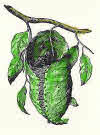
The tailor-bird of India sews leaves together to form a nest.
Was that part of a plan and design, or was it trial and error?
How many eggs were smashed before they learned to sew correctly?
I would suggest that the tailor-bird was given its skill by God the great Designer.
4. Mathematical accuracy is hard for evolution to explain
Architects, mathematicians, and onboard Satnavs…

The amazingly ‘clever’ Bees.
How did bees learn to shape their cells with perfect mathematical accuracy – that is, obtaining the greatest capacity with the least amount of wax?
Also, how did they learn to communicate the distances from the hive, direction and wind strength to other bees, let alone to work these things out?

Designed, or trial and error?
I would suggest that bees have been given these skills by God the great Designer.
5. Being given special tools is hard for evolution to explain
Robber crabs are also known as Coconut crabs or the Palm Thief.
Coconut crabs are generalist scavengers that feed on fallen fruit, carrion, and (to ingest calcium) the shells of other crabs.
‘Coconut crab – crustacean’ Britannica 9
The coconut crab is known for its ability to use its massive pincers (chelae) to crack open coconuts.
The largest coconut crabs can exert a force of 3,300 newtons (about 742 pound-force) with their pincers.
Coconut crabs have also been known to open coconuts by dropping them from trees and striking them repeatedly with their pincers or using their pincers to pierce the coconut’s husk before splitting the seed open.”
The Robber Crab climbs coconut trees with its big claws, then hammers a hole through the coconut’s ‘eye’ and then scoops out the contents with a set of small claws specially adapted for the task.
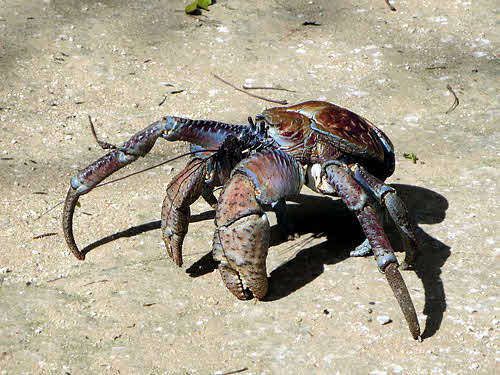
The coconut crab can take a coconut from the ground and cut it to a husk nut, take it with its claw, climb up a tree 10 m (33 ft) high and drop the husk nut, to access the coconut flesh inside.
‘Coconut crab’ Wikipedia 11
They often descend from the trees by falling, and can survive a fall of at least 4.5 m (15 ft) unhurt.
Coconut crabs cut holes into coconuts with their strong claws and eat the contents, although it can take several days before the coconut is opened…
The animal has developed a special technique to do so; if the coconut is still covered with husk, it will use its claws to rip off strips, always starting from the side with the three germination pores, the group of three small circles found on the outside of the coconut.
Once the pores are visible, the coconut crab bangs its pincers on one of them until it breaks.
Afterwards, it turns around and uses the smaller pincers on its other legs to pull out the white flesh of the coconut.
Using their strong claws, larger individuals can even break the hard coconut into smaller pieces for easier consumption.”
The right tools for the job!
Designed, or trial and error?
I would suggest that the Robber Crab was given the tools for the job and the knowledge to do it by God the great Designer.
6. Different spider threads are hard for evolution to explain
Spider threads are amazing, so many different types for specialised tasks.
a) The first type of spider web is the Spiral Orb webs

The Orb Weaver Spiders create the typical circular-shaped web with central spokes.
Then neat intersections are woven out of an elastic capture thread.
The web may contain at least four different kinds of strength, flexibility, stickiness, etc. Orb Weaver Spiders often completely redo their webs daily.
There are over 3100 species commonly found in gardens and forests.
b) The second type of spider web is the Tangled or Cob Webs

These webs look messy but are made up of strands of high-tension catching threads that connect to a floor, branch or something that the victim walks along.
An insect touches the sticky droplets, the line breaks and pulls the insect up into the central tangle as the thread contracts.
Some tangle-web spiders join with their neighbouring spiders to form up to a thousand joined webs reaching hundreds of metres to catch insects and even small birds and mammals.
In this group are the common house spider and the infamous Black Widow Spider.
c) The third type of spider web is the Woolly Webs
These woolly webs have an adhesive silk that is electrostatically-charged to catch it’s prey:
It all starts with the silk-producing cribellar gland.
‘Spider spins electrically charged silk’ 27 Jan 2015 by Monique Brouillette 12
At 60 micrometers, it is among the smallest silk glands ever observed and is covered in microscopic spigots that produce a low-viscosity liquid silk.
In contrast with other spiders, whose silk comes out of the gland intact, scientists were surprised to discover that uloborids’ silk is in a liquid state when it surfaces.
As the spider yanks the silk from the duct, it solidifies into nanoscale filaments.
This “violent hackling” has the effect of stretching and freezing the fibres into shape.
It may even be responsible for increasing their strength, because filaments on the nanoscale become stronger as they are stretched.
In order to endow the fibres with an electrostatic charge, the spider pulls them over a comb like plate located on its hind legs. (This also gives the thread its wool-like appearance.)”
The most well-known spider from this group is the tropical Cribellate Orb Weaver which has no venom and just squeezes its prey to death in the web strands.
d) The fourth type of spider web is the Sheet Webs
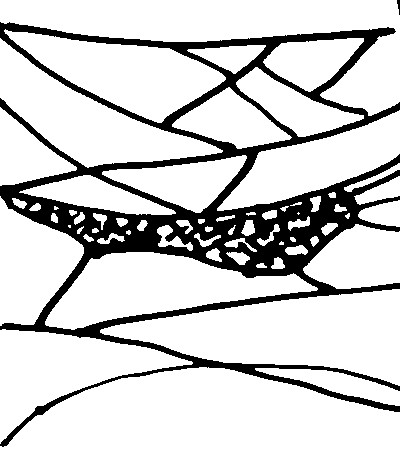
These spiders are known as Sheet Weavers or Money Spiders.
The idea behind these webs is that a flying insect hits an overhead single thread and is knocked down into the catchment net.
These spiders just keep expanding their nets and repairing any holes in them.
There are over 4600 species in the sheet weaving group.
Money spiders are known for floating through the air called “ballooning”.
e) The fifth type of spider web is the Funnel Webs

The Funnel Web spider hides inside the funnel and when it senses movement on the outside it dashes out, bites its prey and pulls it back into the funnel
A common example is grass spiders.
The funnel-web spiders are harmless to humans but they should not be confused with the funnel-web spiders of Australia which are deadly.
f) The sixth type of spider web is the Triangle Weaver webs
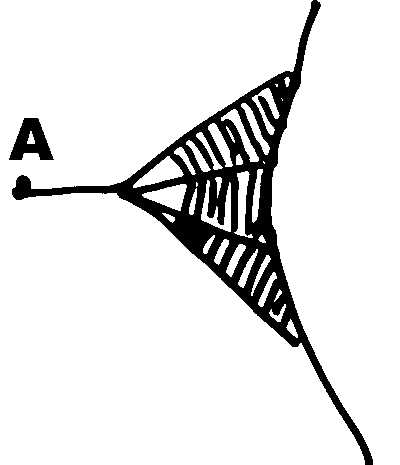
This spider sits at position ‘A’ on the image holding the elastic web line tight.
When its prey is felt on the web, the spider lets go with its back legs, whilst still holding the line with its front legs, so it is catapulted to its prey!
Also, the now slack web mesh starts to close on the caught creature.
Which makes it the only known creature, besides humans, to employ a strategy known as ‘external power amplification’, a new study finds…
‘This Crafty Spider Doesn’t Have Venom…But It Does Have a ‘Slingshot” by Laura Geggel published May 16, 2019 13
Basically, an animal uses an external device (in this case, the spider’s web) to store energy, like a person storing energy in a bow with a pulled-back arrow.
Once the energy is released, the spider is flung forward like a slingshot, greatly exceeding the speeds at which the arachnid could otherwise travel…
The manoeuvre is so fast, the spider can be hurled forward at accelerations of about 2,535 feet/second squared (772 meters/s^2), the researchers found.”
It is a native of the United States and Canada.
g) The seventh type of spider web is the Ogre-faced spider hand-held net

Known as Net-Casting spiders, Gladiator spiders and Ogre-Faced spiders.
This spider hangs on a single strand holding a rectangular web horizontally in its long front legs.
When its prey walks beneath it the spider drops the net over the creature.
This spider has remarkable eyes:
These eyes have a wide field of view and are able to gather available light more efficiently than the eyes of cats and owls.
‘Deinopis’ Wikipedia 14
This is despite the fact that they lack a reflective layer (tapetum lucidum);
instead, each night, a large area of light-sensitive membrane is manufactured within the eyes, and since arachnid eyes do not have irises, it is rapidly destroyed again at dawn.
To aid further in netting prey, the spider places white fecal spots on the surface below the net and uses them for aiming.
The spiders also lack ears and use hairs and receptors on their legs to distinguish sounds at a distance of up to 2 meters.”
h) The eighth type of spider web is the Trapdoor spider web

Trapdoor spiders make a silk-lined, vertical, underground burrow.
This has a camouflaged trapdoor made of soil, vegetation and silk.
The group contains: ‘mouse spiders’, in South America and Australia, ‘folding trapdoor spiders’ from the USA and Japan, ‘brush-footed trapdoor spiders with pantropical distribution, ‘cork-lid trapdoor spiders in tropical and subtropical regions, ‘wafer-lid trapdoor spiders, etc. 15
The spider, upon hearing its prey quickly opens the trap door, grabs the creature and pulls it back into the burrow.
i) The ninth type of spider web is of the Purseweb spider

This makes a tube of silk in a burrow and it extends above the ground level with some debris over the exposed tube.
When its prey comes near it slices through the tube and drags the creature back into the silk hole.
Atypus affinis, a Purseweb spider of Europe, including Southern England.
Atypus muralis is a Purseweb spider from Central Europe to Turkmenistan and it can create a hole about one metre deep.
Atypus piceus is a Purseweb spider of Europe to Moldavia, and Iran. Its burrows are about 30cm deep.
There is one species from the USA and another from Japan, China, and Taiwan. 16
j) The tenth type of spider web is of the Diving bell spider

This spider lives entirely underwater and it attaches its ‘home’ to underwater plants.
It lives in its silk ‘diving bell’ ‘B’ on the image, the web holding the water out and keeping an air bubble inside!
It is from northern and central Europe through Siberia and Central Asia and Japan.
In construction of the diving bell, first a platform of silk is constructed between water plants.
‘Argyroneta aquatica’ by Rose Filoramo 17
The spider then swims to the surface, sticks its abdomen out of the water and holds its hind legs backward around the abdomen, thus enlarging the volume of air that can be captured and transported by the air-trapping hairs.
Air bubble in tow, the water spider dives as best it can to the nest it is constructing, swimming down and climbing along water plants.
Upon reaching the nest, the spider releases the air bubble beneath the diving bell and strengthens and extends the sides of the structure.
Different types of silk are used to anchor the nest to the water plants around it, compose the actual nest structure, and surround the area of the nest with ‘trip-wires,’ which detect the vibrations of an insect in the vicinity. (Bristowe, 1958; De Bakker, et al., 2006)
It has been found that the diving bell is utilized not just as a water-free space, but as an oxygen reservoir or external lung. Water spiders are able to monitor the oxygen concentrations of their diving bell and will resurface to obtain more air when the concentration of oxygen becomes too low and/or the concentration of carbon dioxide becomes too high. (Schutz, et al., 2007)
Females spend most of their time inside the diving bell, acting as ambush predators.
A female sit in her nest with her front legs protruding into the water underneath, waiting for the tell-tale vibrations of silk threads to pounce on her prey…”
What are the different kinds of spiderweb threads?
Here are the different types of spider webs, but not every spider would have all of these different silks:

- Drag-line silk to form a strong skeleton for their web
- Scaffolding silk to support the web whilst constructing it
- Capturing silk to make the ‘net’ for ensnaring prey
- Shielding silk to protect egg sacks
- Rope silk to tie the prey up
- Male sperm web for fertilisation
- Gluing silk to stick things
- Web point bonding silk
How did spiders get to have so many different kinds of web silk and structural designs of the web?
It would appear to be designed and not just randomly appear.
I would suggest that the ability to do all these things has been given by God the great Designer.
7. Painful child-birth for humans but mostly not for animals
Most of the time animals seem to give birth to their young quickly and in a relatively easy manner – it’s only a painful birth when things go wrong.

The World Health Organisation estimates that about 830 women die every day because of complications during pregnancy and childbirth – and that statistic is a 44% reduction from the 1990 level. 18
Professor Jonathan Wells, who studies childhood nutrition at University College London in the UK said:
The figures are just horrifying, it’s extremely rare for mammalian mothers to pay such a high price for offspring production.”
‘Planet 2’ BBC Earth
But for human mothers why is childbirth so painful?
a) What happens to the baby in childbirth
When childbirth is broken down into a sequence of events it shows how complicated, and amazing, the process is:
The changing tilt of the human pelvic openings, from a wide open 10 degrees from the horizontal at the lower outlet while standing to a somewhat gravity-defying 60 degrees at the inlet (on top, while standing), presents additional challenges for the emerging baby.
‘The Evolution of Childbirth?’ by Dr. Elizabeth Mitchell 19
However, God’s design has provided features in both baby and mother to allow the infant to negotiate this path without any instructions or guidance in the normal, uncomplicated birth process.
The new-born’s skull is made of bones that are not yet fused, which allows the bones to overlap and reshape the skull to provide streamlining and moment-by-moment adjustment to the birth canal as the baby enters the outside world.
The anatomy of the pelvis, instead of making human labour difficult, provides an ideal route of exit.
The shape of the bony pelvis and the positioning of the pelvic muscles are such that the baby being propelled through the birth canal tends to twist and turn in the directions most suited for a safe and successful exit.
Multiple but limited options are often available, allowing for variation according to pelvic type and foetal size.
Each option available for a baby’s journey turns the baby’s head so that its smallest dimension enters the curvy birth canal at each level.
The infant’s head, having entered the pelvis looking sideways, must spin 90 degrees as the neck flexes and the head descends.
This rotation must then reverse while extending the neck backwards as the baby descends farther into the pelvis.
The pelvic shape forces the baby to finally twist as the head emerges to allow the roomiest possibility for the delivery of the shoulders.
The importance of these steps becomes more evident when they don’t occur normally.
The whole process would be an engineering nightmare to design due to the changing shape and other dynamic features of the component parts, yet in the majority of births for about six thousand years, the mechanism provided by the Lord has functioned nicely, albeit with the pain incurred in Genesis chapter three.”
b) Why hasn’t childbirth evolved to become painless?
Women have had to endure pain during childbirth throughout history.
Why do human mothers have to suffer so much more than female animals?
Surely if evolution was a reality, we would have evolved to a pain-free birth?
The Lord said to Eve:
I will surely multiply your pain** in childbearing; in pain## you shall bring forth children.”
Genesis 3:16 NIV
Notice that two different words have been used:
- ** עִצָּבוֹן (its.tsa.von) meaning: ‘pain’ This word is also used when the Lord spoke to Adam.
- ## עֶ֫צֶב (e.tsev) meaning: ‘toil, offence’
The Lord said to Adam:
cursed is the ground because of you; in pain** you shall eat of it all the days of your life;
Genesis 3:17-18 ESV
thorns and thistles it shall bring forth for you; and you shall eat the plants of the field.”
In biblical Hebrew, where a similar word is used twice within the same sentence it emphasises and increases the strength of what is being discussed.
So, therefore the pain of giving birth is greatly increased.
If we look in the Septuagint, which is the Greek translation of the Old Testament from the original Hebrew, we can see where the same word is used in the New Testament:
Genesis 3:16 (c. 250 BC) has the Greek λύπη lupē for pain to translate both words, ‘itstsevôn and etsev.
‘Pain in childbirth: result of the Fall or fear?’ ((‘Pain in childbirth: result of the Fall or fear?’ Jonathan Sarfati, CMI–Australia. 26 April 2008. Creation.com
This is the same word as in John 16:21, where Jesus Himself said:
‘A woman giving birth to a child has pain (lupē) because her time has come; but when her baby is born she forgets the anguish because of her joy that a child is born into the world.’
Notice that Jesus accepted the fact that women giving birth suffer pain and anguish, and didn’t blame it on fear. Importantly, He said this was something that occurred during the birth process and was soon over.”
The only answer to ‘why is human childbirth painful’ which makes sense, is the one found in Genesis in the Bible, which says that it is a direct consequence of humanity disobeying God.
The Big Bang theory is the best at answering many of the scientist’s questions but could the Big Bang be wrong?
Some scientists believe in creation as described in Genesis.
See this article on the amazing dragons – were they real?
Also, see the fascinating relationship of obligate mutualism.
Learn about Big Bang and other theories.
Does the enormous diversity of dogs prove evolution?
Modern genetics is uncovering some very interesting things, for example, maternal haplogroups (from the mother) are determined by assessing mitochondrial DNA which can be traced back to the mother of all humans now and she has been called Mitochondrial Eve!
We are told that the ancestors of the horse prove evolution, but in reality, it doesn’t and most experts agree.
Scientists seem to take for granted the physical and scientific laws of this universe without questioning why they are there.
Polaris, the Pole Star, is so far away and yet points north to guide us on Earth, but astronomers have come up with a big difference in its distance from us which can put doubt on the distances of the stars.
Evolutionists have not come up with an answer to how sexual reproduction evolved.
Astronomers and scientists calculate the age of the universe on Hubble’s Law, etc, and the stars and galaxies appear to be billions of years old, but God spoke and the universe came into being, so what if the stars had a ‘history’ – like Adam when he was created as a, say, 20-year-old man.
References open in new tabs:
‘Golden plover’ Scientific name: Pluvialis apricaria The Wildlife Trusts. ↩
‘American Golden Plover’ – U.S. Fish and Wildlife Service ↩
‘American Golden-Plover’ All About Birds, The Cornell Lab ↩
‘American Golden Plover – Pluvialis dominica’ Wildlife Journal Junior ↩
‘Introduction to Grunion Biology’ by Karen Martin, Ph.D ↩
‘The bird that stitches its nest’ by Tammana Begum. Natural History Museum. ↩
Photo credit: David Stanley on Flickr. ↩
‘Spider spins electrically charged silk’ 27 Jan 2015 by Monique Brouillette ↩
‘This Crafty Spider Doesn’t Have Venom…But It Does Have a ‘Slingshot” by Laura Geggel published May 16, 2019 ↩
‘List of Atypidae species’ Wikipedia ↩
‘The Evolution of Childbirth?’ by Dr. Elizabeth Mitchell ↩

